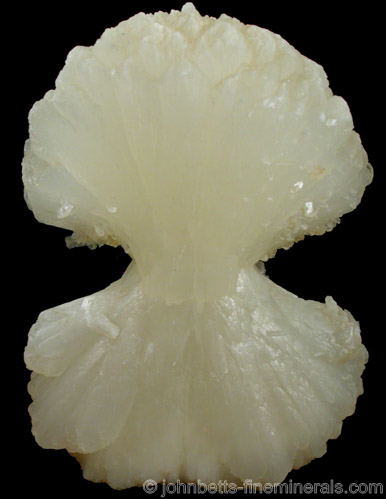The Mineral stilbite

Stilbite is a common member of the zeolite group, and is found in most of the world's important zeolite deposits. Since its original classification, Stilbite was always regarded as a
single mineral species with a slightly variable elemental makeup. In 1997,
the Zeolite Subcommittee of the IMA divided this mineral into individual sub-species, thereby
regarding Stilbite as a series of two members: Stilbite-Ca and Stilbite-Na. Stilbite-Ca is the calcium-dominating member, and Stilbite-Na is the sodium-dominating member. Stilbite-Ca is the more common type, and almost all Stilbite in collections are of the Stilbite-Ca type. A
distinction between the two Stilbite types is rarely made, and most collectors simply refer to this mineral as Stilbite. Stilbite is named for the Greek word stilbein, which means "to glitter", in reference to the luster of this mineral which is pearly on cleavage surfaces.
Chemical Formula
Stilbite-Ca: NaCa4Al9Si27O72 · 28(H2O)
Stilbite-Na: Na9Al9Si27O72 · 28(H2O)
Color
White, beige, peach, pink, orange, light yellow, brown. Less commonly gray, red, or green.
Crystal System
Monoclinic
Properties
Streak
Colorless |
Hardness
3.5 - 4 |
Transparency
Transparent to translucent |
Specific Gravity
2.1 - 2.2 |
Luster
Vitreous, pearly, dull |
Cleavage
1,1 |
Fracture
Uneven |
Tenacity
Brittle |
Other ID Marks
Occasionally fluorescent yellow in UV light.
|
Crystal Habits
Single crystals are tabular and flattened, and usually with pointed termination. However, single individual crystals are very uncommon; crystals will usually be in platy aggregates, or more often in distinct curved aggregates of fan-shaped or wheat sheaf bundles, and in unique "bow tie" formations. Also radiating, globular, in bladed groups, as rounded balls of radiating crystals, and fibrous. Crystals are often doubly terminated, and aggregates may be twinned in interesting bisecting habits.
Uses
Large and well-shaped Stilbite crystals are of interest to
collectors, especially when in wheat sheaf or bow tie form. Stilbite as a zeolite is also used in water purifiers
and chemical filters.
Noteworthy Localities
Stilbite is a common mineral and found worldwide. Only the most significant deposits will be mentioned here. The largest and most significant finds of Stilbite are from India, in the state of Maharshtra. Several localities there have produced outstanding examples of this mineral, with the cities such as Pune (Poona), Jalgaon, Nasik, Aurangabad, Mumbai, and Ahmadnagar being the most significant.
Iceland is a classic producer of Stilbite, and the locality of Teigarhorn, in Berufjördur, is especially noteworthy. The Faroe Islands (Denmark), which are composed of volcanic basalt, are also an important and classic locality. In Sweden, excellent brownish-yellow Stilbite crystal plates come from Malmberget, Lappland.
In the U.S., New Jersey is the most prolific producer of Stilbite, with many localities producing outstanding examples of this mineral. Foremost in importance are Paterson and Prospect Park, Passaic Co., producers of large and well-formed bow-ties and wheat sheaves. Highly lustrous white and cream Stilbite has come from the Braen Quarry, Haledon, Passaic Co., especially in white, rounded balls; and orange to brown crystal plates from Montclair/Little Falls, Essex/Passaic Cos. Exceptional bright orange Stilbite comes from the diabase at the Moore's Station Quarry, near Lambertville; and dense, lighter colored plates once came from Laurel Hill (Snake Hill), Secaucus, Hudson Co. Tan colored crystals came from the Millington Quarry, Somerset Co.; and yellow and orange radial aggregates from the Fanwood Quarry, Somerset Co.
Connecticut has produced fine Stilbite crystals at the O&G Quarry, Woodbury, Litchfield Co.; and the prolific locality of the Thomaston Dam railroad cut, Litchfield Co. was once a good producer. Other notable U.S. occurrences include the Fairfax quarry, Centreville, Fairfax Co., Virginia; Mill Creek, Polk Co., Oregon; the Skookumchuck Dam, Bucoda, Thurston Co., Washington; and Kalama and Signal Peak, Cowlitz Co., Washington.
In Canada, good crystals come from several localities in Nova Scotia
near the Bay of Fundy, such as Cape D'or, Horshoe Cove, Wasson's Bluff, and
Partridge Island.
Stilbite-Na is not commonly identified. Its type locality is Cape Pula, Cagliari, on the island of Sardinia, Italy.
Distingushing Similar Minerals
Heulandite - Forms in a different crystal shape; otherwise difficult to distinguish.
Stellerite - Very similar and can be difficult to distinguish, however Stellerite usually forms more perfect hemispherical balls.